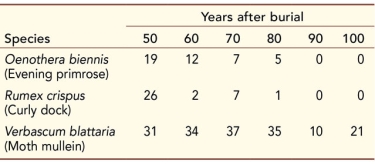Refer to the table.  In 1879, W.J.Beal began an experiment that he could not hope to finish in his lifetime.He prepared 20 lots of seeds for long-term storage.Each lot consisted of 50 seeds from each of 23 species.He mixed each lot of seeds with sand and placed the mixture in an uncapped bottle, then buried all the bottles in a sandy knoll.At 5- or 10-year intervals over the next century, biologists excavated a bottle and checked the viability of its contents.The table shows the number of germinating seeds (of the original 50) from three of the species in years 50-100 of this ongoing experiment.Calculate the percentage of the seeds that were still viable for these three species in years 50-100, and graph percent viable seeds as a function of years after burial.
In 1879, W.J.Beal began an experiment that he could not hope to finish in his lifetime.He prepared 20 lots of seeds for long-term storage.Each lot consisted of 50 seeds from each of 23 species.He mixed each lot of seeds with sand and placed the mixture in an uncapped bottle, then buried all the bottles in a sandy knoll.At 5- or 10-year intervals over the next century, biologists excavated a bottle and checked the viability of its contents.The table shows the number of germinating seeds (of the original 50) from three of the species in years 50-100 of this ongoing experiment.Calculate the percentage of the seeds that were still viable for these three species in years 50-100, and graph percent viable seeds as a function of years after burial.
Definitions:
Abnormal Behavior
Actions, thoughts, or feelings that are atypical within a cultural context, potentially impairing functioning or causing distress.
Interpretation
The act of explaining the meaning of something, often used in the context of analyzing texts or behaviors.
Challenges Assertions
Involves questioning or disputing claims or statements, often to clarify truth or foster critical thinking.
Neurotransmitters
Chemical substances that transmit signals across a synapse from one neuron to another in the brain.
Q10: In angiosperms, double fertilization results in the
Q41: Refer to the figure. <img src="https://d2lvgg3v3hfg70.cloudfront.net/TB5650/.jpg" alt="Refer
Q70: A growth pattern that contributed to evolution
Q77: Rhizoids, which function to attach the fungus
Q105: _ have thin pseudopods stiffened by microtubules,
Q175: Seed plants<br>A) produce one kind of spore.<br>B)
Q195: An antheridium is _ and produces _.<br>A)
Q211: The vascular system in land plants consists
Q231: Without water, the fern life cycle could
Q258: During sexual reproduction in fungi, which structures